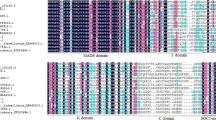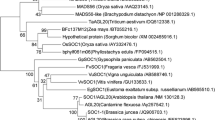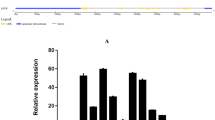Abstract
The Short Vegetative Phase (SVP) gene is a key regulator for floral transition and development. Although SVP-like genes have been identified and characterized in many plant species, their orthologs in bamboo have not been characterized. In this study, one SVP homolog was isolated from lei bamboo based on the P. edulis transcriptome database and designated as PvSVP2. Phylogenetic analysis showed that PvSVP2 was closely related to rice OsMADS47. Expression analysis revealed that PvSVP2 was widely expressed in different tissues but significantly in vegetative tissues. Moreover, it has higher transcript levels in the late stages of flower development. Overexpression of PvSVP2 in Arabidopsis thaliana caused the early flowering and abnormal floral morphologies. Further, the qRT-PCR analysis showed that the genes regulating flowering time (FT and SOC1) and flower development (AP1, AP3 and PI) expressions significantly increased in transgenic A. thaliana lines and correlated with PvSVP2 expression. The subcellular location of PvSVP2 in both onion epidermal cells and A. thaliana protoplast was localized in the nucleus and cytomembrane. Through yeast two-hybrid and BIFC assays, we identified that PvSVP2 interacts with PvMADS56 (a SOC1 homolog) and PvVRN1 (an AP1 homolog). These results suggested that PvSVP2 may play an essential role in the flowering process of bamboo by regulating the PvMADS56 and PvVRN1. Besides, we purified and obtained the PvSVP2 recombinant protein by prokaryotic inducement. Our data will provide information to understand the characterization and function of PvSVP2 and be beneficial to illustration the molecular mechanism of bamboo flowering.
Key message
PvSVP2, a bamboo SVP homolog, might cause early flowering and abnormal floral organs by interacting with PvMADS56 and PvVRN1.









Similar content being viewed by others
Data availability
All data generated or analyzed during this study are included in this article and supplementary files.
References
Amasino RM, Michaels SD (2010) The timing of flowering. Plant Physiol 154:516–520. https://doi.org/10.1104/pp.110.161653
Andrés F, Porri A, Torti S, Mateos J, Romera-Branchat M, García-Martínez JL, Fornara F, Gregis V, Kater MM, Coupland G (2014) SHORT VEGETATIVE PHASE reduces gibberellin biosynthesis at the Arabidopsis shoot apex to regulate the floral transition. PANS 111:E2760–E2769. https://doi.org/10.1073/pnas.1409567111
Biswas P, Chakraborty S, Dutta S, Pal A, Das M (2016) Bamboo flowering from the perspective of comparative genomics and transcriptomics. Front in Plant Sci 7:1900. https://doi.org/10.3389/fpls.2016.01900
Bouché F, Lobet G, Tocquin P, Périlleux C (2015) FLOR-ID: an interactive database of flowering-time gene networks in Arabidopsis thaliana. Nucleic Acids Res 44:D1167–D1171. https://doi.org/10.1093/nar/gkv1054
de Folter S, Immink RGH, Kieffer M, Pařenicová L, Henz SR, Weigel D, Busscher M, Kooiker M, Colombo L, Kater MM, Davies B, Angenent GC (2005) Comprehensive interaction map of the Arabidopsis MADS box transcription factors. Plant Cell 17:1424–1433. https://doi.org/10.1105/tpc.105.031831
Dutta S, Biswas P, Chakraborty S, Mitra D, Pal A, Das M (2018) Identification, characterization and gene expression analyses of important flowering genes related to photoperiodic pathway in bamboo. BMC Genomics 19:190. https://doi.org/10.1186/s12864-018-4571-7
Dutta S, Deb A, Biswas P et al (2021) Identification and functional characterization of two bamboo FD gene homologs having contrasting effects on shoot growth and flowering. Sci Rep-UK 11:7849. https://doi.org/10.1038/s41598-021-87491-6
Fornara F, Gregis V, Pelucchi N, Colombo L, Kater M (2008) The rice StMADS11-like genes OsMADS22 and OsMADS47 cause floral reversions in Arabidopsis without complementing the svp and agl24 mutants. J Exp Bot 59:2181–2219. https://doi.org/10.1093/jxb/em083
Gao Y, Gao Y, Fan M, Yuan L, Wu Z, Zhang Q (2017) Overexpression of Chrysanthemum morifolium SVP gene delays blossoming and regulates inflorescence architecture in transgenic Arabidopsis. Can J Plant Sci 97:1130–1139. https://doi.org/10.1139/cjps-2017-0007
Gregis V, Sessa A, Colombo L, Kater MM (2006) AGL24, SHORT VEGETATIVE PHASE, and APETALA1 redundantly control AGAMOUS during early stages of flower development in Arabidopsis. Plant Cell 18:1373–1382. https://doi.org/10.1111/j.1365-313X.2009.03986.x
Gregis V, Sessa A, Colombo L, Kater MM (2008) AGAMOUS-LIKE24 and SHORT VEGETATIVE PHASE determine floral meristem identity in Arabidopsis. Plant J 56:891–902. https://doi.org/10.1111/j.1365-313X.2008.03648.x
Hartmann U, Hohmann S, Nettesheim K, Wisman E, Saedler H, Huijser P (2000) Molecular cloning of SVP: a negative regulator of the floral transition in Arabidopsis. Plant J 21:351–360. https://doi.org/10.1046/j.1365-313x.2000.00682.x
Hou D, Zhao ZY, Hu QT, Li L, Vasupalli N, Zhuo J, Zeng W, Wu AM, Lin XC (2020) PeSNAC-1, a NAC transcription factor from moso bamboo (Phyllostachys edulis) confers tolerance to salinity and drought stress in transgenic rice. Tree Physiol 40:1792–1806. https://doi.org/10.1093/treephys/tpaa099
Hou D, Li L, Ma TF, Pei JL, Zhao ZY, Lu MZ, Wu AM, Lin XC (2021) The SOC1-like gene BoMADS50 is associated with the flowering of Bambusa oldhamii. Hortic Res 8:133. https://doi.org/10.1038/s41438-021-00557-4
Jang S, Torti S, Coupland G (2009) Genetic and spatial interactions between FT, TSF and SVP during the early stages of floral induction in Arabidopsis. Plant J 60:614–625. https://doi.org/10.1111/j.1365-313X.2009.03986.x
Jaudal M, Monash J, Zhang L, Wen J, Mysore KS, Macknight R, Putterill J (2013) Overexpression of Medicago SVP genes causes floral defects and delayed flowering in Arabidopsis but only affects floral development in Medicago. J Exp Bot 65:429–442. https://doi.org/10.1093/jxb/ert384
Jiang Y, Peng J, Zhang Z, Lin S, Lin S, Yang X (2019) The role of EjSVPs in flower initiation in Eriobotrya japonica. Int J Mol Sci 20:5933. https://doi.org/10.3390/ijms20235933
Jiao YL, Hu QT, Zhu Y, Zhu LF, Ma TF, Zeng HY et al (2019) Comparative transcriptomic analysis of the flower induction and development of the Lei bamboo (Phyllostachys violascens). BMC Bioinform 20:1–12. https://doi.org/10.1186/s12859-019-3261-z
Lee S, Choi SC, An G (2008a) Rice SVP-group MADS-box proteins, OsMADS22 and OsMADS55, are negative regulators of brassinosteroid responses. Plant J 54:93–105. https://doi.org/10.1111/j.1365-313X.2008.03406.x
Lee J, Oh M, Park H, Lee I (2008b) SOC1 translocated to the nucleus by interaction with AGL24 directly regulates LEAFY. Plant J 55:832–843. https://doi.org/10.1111/j.1365-313X.2008.03552.x
Lee JH, Park SH, Ahn JH (2012) Functional conservation and diversification between rice OsMADS22/OsMADS55 and Arabidopsis SVP proteins. Plant Sci 185:97–104. https://doi.org/10.1016/j.plantsci.2011.09.003
Lee JH, Ryu H-S, Chung KS, Posé D, Kim S, Schmid M, Ahn JH (2013) Regulation of temperature-responsive flowering by MADS-Box transcription factor repressors. Science 342:628–632. https://doi.org/10.1126/science.1241097
Li D, Liu C, Shen L, Wu Y, Chen H, Robertson M, Helliwell CA, Ito T, Meyerowitz E, Yu H (2008) A repressor complex governs the integration of flowering signals in Arabidopsis. Dev Cell 15:110–120. https://doi.org/10.1016/j.devcel.2008.05.002
Li ZM, Zhang JZ, Mei L, Deng XX, Hu CG, Yao JL (2010) PtSVP, an SVP homolog from trifoliate orange (Poncirus trifoliata L. Raf.), shows seasonal periodicity of meristem determination and affects flower development in transgenic Arabidopsis and tobacco plants. Plant Mol Biol 74:129–142. https://doi.org/10.1007/s11103-010-9660-1
Lin SY, Mao GX (2007) The habit and regeneration of bamboo flowering. For Sci Technol 32:23–25 (In Chinese)
Liu C, Xi WY, Shen LS, Tan CP, Yu H (2009) Regulation of floral patterning by flowering time genes. Dev Cell 16:711–722. https://doi.org/10.1016/j.devcel.2009.03.011
Liu SN, Ma TF, Ma LY, Lin XC (2016a) Ectopic expression of PvSOC1, a homolog of SOC1 from Phyllostachys violascens, promotes flowering in Arabidopsis and rice. Acta Physiol Plant 38:1–9. https://doi.org/10.1007/s11738-016-2186-7
Liu SN, Zhu LF, Lin XC, Ma LY (2016b) Overexpression of the repressor gene PvFRI-L from Phyllostachys violascens delays flowering time in transgenic Arabidopsis thaliana. Biol Plant 60:401–409. https://doi.org/10.1007/s10535-016-0614-6
Liu SN, Qi TT, Ma JJ, Ma T, Ma LY, Lin XC (2016c) Ectopic expression of a SOC1 homolog from Phyllostachys violascens alters flowering time and identity of floral organs in Arabidopsis thaliana. Trees 30:2203–2215. https://doi.org/10.1007/s00468-016-1445-y
Liu SN, Li XF, Yang H, Qian QX, Lin XC (2020) Ectopic expression of BoYAB1, a member of YABBY gene family in Bambusa oldhamii, causes leaf curling and late flowering in Arabidopsis thaliana. J Hortic Sci Biotechnol 95:169–174. https://doi.org/10.1080/14620316.2019.1661289
Livak KJ, Schmittgen TD (2001) Analysis of relative gene expression data using real-time quantitative PCR and the 2−ΔΔCT method. Methods 25:402–408. https://doi.org/10.1006/meth.2001.1262
Ma JJ, Liu SN, Zhu LF, Qi TT, Lin XC (2016) Cloning and functional analysis of VRN1 gene from Phyllostachys violascens. J Nucl Agric Sci 30:1699–1705 (In Chinese)
Marín-González E, Matías-Hernández L, Aguilar-Jaramillo AE, Lee JH, Ahn JH, Suárez-López P, Pelaz S (2015) SHORT VEGETATIVE PHASE up-regulates TEMPRANILLO2 floral repressor at low ambient temperatures. Plant Physiol 169:1214–1224. https://doi.org/10.1104/pp.15.00570
Masiero S, Li M-A, Will I, Hartmann U, Saedler H, Huijser P, Schwarz-Sommer Z, Sommer H (2004) INCOMPOSITA: a MADS-box gene controlling prophyll development and floral meristem identity in Antirrhinum. Development 131:5981–5990. https://doi.org/10.1242/dev.01517
Mateos JL, Madrigal P, Tsuda K, Rawat V, Richter R, Romera-Branchat M, Fornara F, Schneeberger K, Krajewski P, Coupland G (2015) Combinatorial activities of SHORT VEGETATIVE PHASE and FLOWERING LOCUS C define distinct modes of flowering regulation in Arabidopsis. Genome Biol 16:31. https://doi.org/10.1186/s13059-015-0597-1
Michaels SD, Ditta G, Gustafson-Brown C, Pelaz S, Yanofsky M, Amasino RM (2003) AGL24 acts as a promoter of flowering in Arabidopsis and is positively regulated by vernalization. Plant J 33:867–874. https://doi.org/10.1046/j.1365-313X.2003.01671.x
Mo X, Luo C, Yu HX, Chen JW, Liu Y, Xie XJ, Fan ZY, He XH (2021) Isolation and functional characterization of two SHORT VEGETATIVE PHASE homologous genes from Mango. Int J Mol Sci 22:9802. https://doi.org/10.3390/ijms22189802
Parcy F (2005) Flowering: a time for integration. Int J Dev Biol 49:585–593. https://doi.org/10.1387/ijdb.041930fp
Peng ZH, Lu Y, Li LB, Zhao Q, Feng Q, Gao ZM et al (2013) The draft genome of the fast-growing non-timber forest species moso bamboo (Phyllostachys heterocycla). Nat Genet 45:456–461. https://doi.org/10.1038/ng.2569
Qi FY, Hu T, Peng ZH, Gao J (2013) Screening of reference genes used in qRT-PCR and expression analysis of PheTFL1 gene in Moso Bamboo. Acta Bot Borea 33:0048–0052 (In Chinese)
Sentoku N, Kato H, Kitano H, Imai R (2005) OsMADS22, an STMADS11-like MADS-box gene of rice, is expressed in non-vegetative tissues and its ectopic expression induces spikelet meristem indeterminacy. Mol Genet Genomics 273:1–9. https://doi.org/10.1007/s00438-004-1093-6
Sharma P, Dhanwantri K, Mehta S (2014) Bamboo as a building material. Int J Civ Eng 5:249–254
Tamura K, Peterson D, Peterson N, Stecher G, Nei M, Kumar S (2011) MEGA5: molecular evolutionary genetics analysis using maximum likelihood, evolutionary distance, and maximum parsimony methods. Mol Biol Evol 28:2731–2739. https://doi.org/10.1093/molbev/msr121
Tang XL, Liang MX, Han JJ, Cheng JS, Zhang HX, Liu XH (2019) Ectopic expression of LoSVP, a MADS-domain transcription factor from lily, leads to delayed flowering in transgenic Arabidopsis. Plant Cell Rep 39:289–298. https://doi.org/10.1007/s00299-019-02491-1
Trevaskis B, Tadege M, Hemming MN, Peacock WJ, Dennis ES, Sheldon C (2006) Short vegetative phase-like MADS-Box genes inhibit floral meristem identity in barley. Plant Physiol 143:225–235. https://doi.org/10.1104/pp.106.090860
Wang YC, Klein TM, Fromm M, Cao J, Sanford JC, Wu R (1988) Transient expression of foreign genes in rice, wheat and soybean cells following particle bombardment. Plant Mol Biol 11:433–439. https://doi.org/10.1007/BF00039024
Wang J, Jiu S, Xu Y, Sabir IA, Wang L, Ma C, Xu W, Wang S, Zhang C (2021) SVP-like gene PavSVP potentially suppressing flowering with PavSEP, PavAP1, and PavJONITLESS in sweet cherries (Prunus avium L.). Plant Physiol Biochem 159:277–284. https://doi.org/10.1016/j.plaphy.2020.12.013
Wu RM, Walton EF, Richardson AC, Wood M, Hellens RP, Varkonyi-Gasic E (2011) Conservation and divergence of four kiwifruit SVP-like MADS-box genes suggest distinct roles in kiwifruit bud dormancy and flowering. J Exp Bot 63:797–807. https://doi.org/10.1093/jxb/ert384
Wu R, Wang T, Warren BAW, Allan AC, Macknight RC, Varkonyi-Gasic E (2017) Kiwifruit SVP2 gene prevents premature budbreak during dormancy. J Exp Bot 68:1071–1082. https://doi.org/10.1093/jxb/erx014
Yao W, Li C, Lin S, Ren L, Wan Y, Zhang L, Ding Y (2020) Morphological characteristics and transcriptome comparisons of the shoot buds from flowering and non-flowering Pleioblastus pygmaeus. Forests 11:1229. https://doi.org/10.3390/f11111229
Yoo SD, Cho YH, Sheen J (2007) Arabidopsis mesophyll protoplasts: a versatile cell system for transient gene expression analysis. Nat Protoc 2:1565–1572. https://doi.org/10.1038/nprot.2007.199
Zhang Y, Tang D, Lin X et al (2018) Genome-wide identification of MADS-box family genes in moso bamboo (Phyllostachys edulis) and a functional analysis of PeMADS5 in flowering. BMC Plant Biol 18:176. https://doi.org/10.1186/s12870-018-1394-2
Zheng ZG, Yang XM, Fu YP, Zhu LF, Wei HT, Lin XC (2017) Overexpression of PvPin1, a bamboo homolog of PIN1-Type Parvulin 1, delays flowering time in transgenic Arabidopsis and rice. Front Plant Sci 8:1526. https://doi.org/10.3389/fpls.2017.01526
Zheng X, Lin S, Fu H, Wan Y, Ding Y (2020) The bamboo flowering cycle sheds light on flowering diversity. Front Plant Sci 11:381. https://doi.org/10.3389/fpls.2020.00381
Zhou FY, Yu Q, Zhang Y, Yao CC, Han YJ (2020) StMADS11 Subfamily gene PfMADS16 from Polypogon fugax regulates early flowering and seed development. Front Plant Sci 11:525. https://doi.org/10.3389/fpls.2020.00525
Acknowledgements
Our work was funded by National Natural Science Foundation of China (31971735), the Natural Science Foundation of Zhejiang Province (LZ20C160002) and the State Key Laboratory of Subtropical Silviculture (ZY20180203).
Author information
Authors and Affiliations
Contributions
SL: Methodology, Formal analysis, Roles/Writing-original draft. NV: Formal analysis, Writing-review & editing, DH: Writing-review & editing. XL: Conceptualization, Writing-review & editing, Funding acquisition, Project administration.
Corresponding author
Ethics declarations
Conflict of interest
The authors declare no conflict of interest.
Additional information
Communicated by Konstantin V. Kiselev.
Publisher's Note
Springer Nature remains neutral with regard to jurisdictional claims in published maps and institutional affiliations.
Supplementary Information
Below is the link to the electronic supplementary material.
11240_2022_2343_MOESM1_ESM.docx
Supplementary file1 (DOCX 18 kb). Supplementary Materials Supplementary Data for this article are available at Plant Cell, Tissue and OrganCulture (PCTOC). Fig. S1: Self-activation of these three proteins were examined in yeast two-hybrid

Rights and permissions
About this article
Cite this article
Liu, S., Vasupalli, N., Hou, D. et al. Ectopic expression of a bamboo SVP-like gene alters flowering time and floral organs in Arabidopsis thaliana. Plant Cell Tiss Organ Cult 150, 721–732 (2022). https://doi.org/10.1007/s11240-022-02343-z
Received:
Accepted:
Published:
Issue Date:
DOI: https://doi.org/10.1007/s11240-022-02343-z




